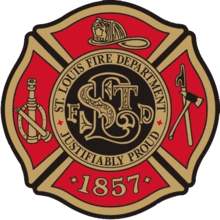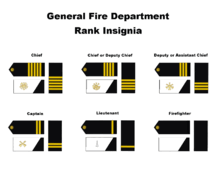St. Louis Fire Department
 | |
| "Justifiably Proud" | |
| Operational area | |
|---|---|
| Country |
|
| State |
|
| City |
|
| Agency overview[1][2] | |
| Established | September 14, 1857 |
| Annual calls | 63,388 fire 78,000 ems (2014) |
| Employees |
776 (2015)
|
| Annual budget | $57,468,076 (2015) |
| Staffing | Career |
| Commissioner | Dennis Jenkerson |
| IAFF | 73 |
| Facilities and equipment[3] | |
| Battalions | 8 |
| Stations | 36 |
| Engines | 9 |
| Trucks | 22 |
| Tillers | 0 |
| Squads | 2 |
| Ambulances | 12 |
| HAZMAT | 3 |
| Fireboats | 4 |
| Rescue boats | 2 |
| Website | |
| Official website | |
| IAFF website | |
The St. Louis Fire Department(STLFD) provides fire protection and emergency medical services to the city of St. Louis, Missouri. The department is also the second oldest paid fire department in the United States.[4][5] The STLFD is responsible for 62.5 square miles (162 km2) and has a population of approximately 321,000 with a daytime population over 1 million and with events going on.[1] The department is a division of the St. Louis Department of Public Safety.
Departmental History
The first organized fire department in St. Louis was created in 1822, had several volunteer fire department in the area. An ordinance was passed to purchase the equipment, which primarily consisted of leather buckets. When the alarm sounded, members of the department would fetch their bucket and rush to scene.[6] On September 14, 1857 the department transitioned to an all paid department. St. Louis Fire Department is the second oldest fire department, only second to Cincinnati.[7]
Specialized Units
In addition to fire suppression and emergency medical services, the St. Louis Fire Department also has specialized units which include:
- Aircraft Rescue Firefighting at Lambert-St. Louis International Airport
- Hazmat Task Force
- Marine Operations with a Boston Whaler called the "Jack Buck," which is permanently moored on the Mississippi River, along with several other small *Rapidly deployable boats.
- Dive & Swift Water Rescue
- High-Angle Rope Rescue
- Trench & Collapse Rescue
Ranks of the STLFD

In the St. Louis Fire Department, helmet colors often denote a fire fighter's rank or position. In general, white helmets denote chief officers, while red helmets may denote company officers, but the specific meaning of a helmet's color or style varies from region to region and department to department. The rank of an officer in St. Louis Fire Department is most commonly denoted by a number of speaking trumpets, a reference to a megaphone like device used in the early days of the fire service, although typically called "bugle" in today's parlance. Ranks proceed from one (lieutenant) to five (fire chief) bugles.
Firefighter
|
Engineer/Technician/Sergeant
|
Lieutenant
|
Captain
|
Battalion Chief/District Chief
|
Division Chief or Assistant /Deputy Asst.
Chief/Commissioner
|
Deputy Fire Chief/Commissioner
|
Fire Chief/Commissioner
|
- Note: In place of Bugle(s) Captains and Lieutenants assigned to: Ladder Companies are signified by axe(s), Rescue Companies by Life gun(s), Squad Companies by crossed Ladder(s) and Stacked Tip Nozzle(s) and Marine Companies by Bugle(s) with Anchor.
Fireboats

As of 2013 there are four small fireboats operated in St. Louis.[9] The largest two are named.[10][11] The 27 feet (8.2 m) Jack Buck was commissioned in 2003 and the 44 feet (13 m) Stan Musial in 2013.
Stations and apparatus
As of May 2016, below is a complete listing of all Fire Station and Apparatus Locations in the city of St. Louis according to Battalion District.[12][13]
Notable Incidents
Great Fire of 1849
On May 17 at 9:00 p.m. an enormous fire broke out in the heart of St. Louis.[14] A steamboat named "The White Cloud" sitting on Cherry Street was on fire. The Fire Department, which at that time consisted of 9 hand engines and hose reels, responded to the scene. The moorings holding the boat broke and the steamer floated down stream setting 22 other steamers on fire as it went.[14]
The flames leaped from building to building sweeping everything on the levee for four blocks.[14] The Firemen, after fighting for over eight hours, were completely exhausted. The entire business portion of the city appeared lost. In a last ditch effort to save the city, six buildings were spread with explosive powder and blown up. When the fire was finally contained after 11 hours, 430 buildings were destroyed, 23 steamboats along with over a dozen other boats were lost and 3 people had died including a Fire Captain.[14]
References
- 1 2 "About". St. Louis Fire Department. Retrieved 26 May 2015.
- ↑ "2015 Budget" (PDF). St. Louis. Retrieved 26 May 2015.
- ↑ "Fire Suppression". St. Louis Fire Department. Retrieved 26 May 2015.
- ↑ "St. Louis Fire Department". St. Louis Fire Department. Retrieved 26 May 2015.
- ↑ https://stlouis-mo.gov/government/departments/public-safety/fire/
- ↑ "Volunteer Department". St. Louis Fire Department. Retrieved 26 May 2015.
- ↑ "History". St. Louis Fire Department. Retrieved 26 May 2015.
- ↑ "History". St. Louis Fire Department. Retrieved 27 Nov 2016.
- ↑ Brett Blume (2012-05-24). "New Rescue Boats To Patrol St. Louis Riverfront". CBS News. Archived from the original on 2012-06-03. Retrieved 2013-09-30.
- ↑ "St. Louis Fire Department names newest marine unit "The Stan Musial"". Fox News. 2013-09-29. Archived from the original on 2013-09-30.
The St. Louis Fire Department bought the boat, because of the growth of the St. Louis inland ports, which is now the third largest port in the United States.
- ↑ Bob Hamilton (2013-09-29). "St. Louis Fire Department Getting New Boat". CBS News. Archived from the original on 2013-09-30. Retrieved 2013-09-30.
It can pump up to 7,000 gallons of water or fire-suppressing foam per minute and can fight fires even while it’s moving.
- ↑ "Station Locations". St. Louis Fire Department. Retrieved 26 May 2015.
- ↑ https://stlouis-mo.gov/government/departments/public-safety/fire/firehouse-locations.cfm
- 1 2 3 4 "Great Fire". St. Louis Fire Department. Retrieved 26 May 2015.
Coordinates: 38°37′38″N 90°11′52″W / 38.62722°N 90.19778°W